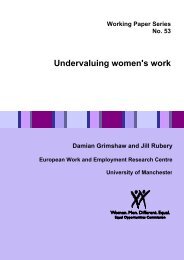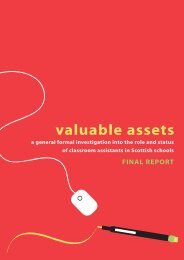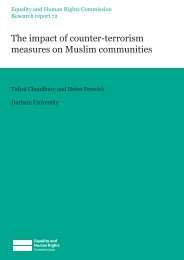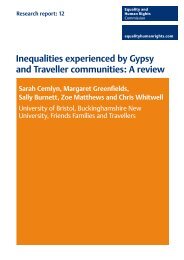Chapter 10: Education - Equality and Human Rights Commission
Chapter 10: Education - Equality and Human Rights Commission
Chapter 10: Education - Equality and Human Rights Commission
You also want an ePaper? Increase the reach of your titles
YUMPU automatically turns print PDFs into web optimized ePapers that Google loves.
312<br />
<strong>Chapter</strong> <strong>10</strong>: <strong>Education</strong><br />
Age<br />
In all three nations, boys are more likely to be excluded at a younger age than girls.<br />
The most common point for both boys <strong>and</strong> girls to be excluded is at ages 13 <strong>and</strong><br />
14 (equivalent to year groups 9 <strong>and</strong> <strong>10</strong> in Engl<strong>and</strong> 23 <strong>and</strong> Wales 24 <strong>and</strong> Stage 4 in<br />
Scotl<strong>and</strong> 25 ); In Engl<strong>and</strong>, around 54% of all permanent exclusions were of pupils<br />
from these age groups.<br />
Socio-economic groups<br />
Pupils in Engl<strong>and</strong> eligible for FSM were over twice as likely to be permanently<br />
excluded than the average, accounting for 38% of permanent exclusions. In<br />
Scotl<strong>and</strong>, 41% of permanent exclusions were among pupils from the 20% of areas<br />
with the highest levels of multiple deprivation in 2006 compared to just 3%<br />
among pupils from the 20% of areas associated with the lowest levels of multiple<br />
deprivation.<br />
<strong>Chapter</strong> <strong>10</strong><br />
Disability<br />
Nearly three-quarters (71%) of permanent exclusions in Engl<strong>and</strong> involved pupils<br />
with some form of SEN. The likelihood of permanent exclusion was particularly<br />
high for those pupils without a statement, who made up 64% of all exclusions<br />
in 2008/09. The data for 2008/09 show that 24 out of every <strong>10</strong>,000 pupils with<br />
statements of SEN are excluded <strong>and</strong> 30 out of every <strong>10</strong>,000 pupils with SEN<br />
without a statement are excluded. This compares with 3 in every <strong>10</strong>,000 pupils<br />
with no SEN. In Wales, 53% of permanent exclusions involved pupils with some<br />
form of SEN.<br />
For those for whom the data were available in Scotl<strong>and</strong>, 23% of permanent<br />
exclusions were among pupils with some form of Additional Support Need (ASN).<br />
Ethnicity<br />
In 2008/09, 77% of exclusions in Engl<strong>and</strong> related to White pupils. However in<br />
terms of the permanent exclusion rate per <strong>10</strong>,000 pupils, pupils from non-White<br />
British backgrounds were as likely to be permanently excluded (<strong>10</strong> per <strong>10</strong>,000<br />
pupils) as pupils overall. However, more detailed analysis of the permanent<br />
exclusion data show large differences between ethnic minority groups:<br />
• The lowest permanent exclusion rates were found among members of the Asian<br />
community (5 per <strong>10</strong>,000 pupils) <strong>and</strong> children with one White/one Asian parent<br />
or from ‘Other White’ backgrounds (both groups had a rate of 8 per <strong>10</strong>,000 pupils).<br />
• The permanent exclusion rate for White British pupils (9 per <strong>10</strong>,000 pupils) was<br />
similar to the overall rate. Other pupils with average permanent exclusion rates<br />
were those from Black African, Irish, Mixed White/Black African <strong>and</strong> other<br />
Mixed. Ethnic backgrounds (all had permanent exclusion rates of <strong>10</strong>-11 per<br />
<strong>10</strong>,000 pupils). These rates were just above that for White pupils showing<br />
23<br />
DCSF 2009.<br />
24<br />
Welsh Assembly Government 20<strong>10</strong>a.<br />
25<br />
Scottish Government 20<strong>10</strong>a.












